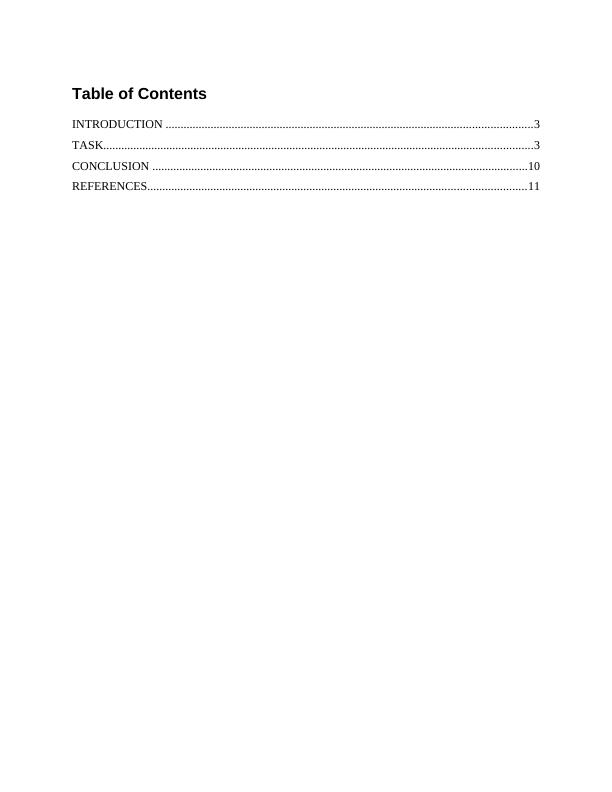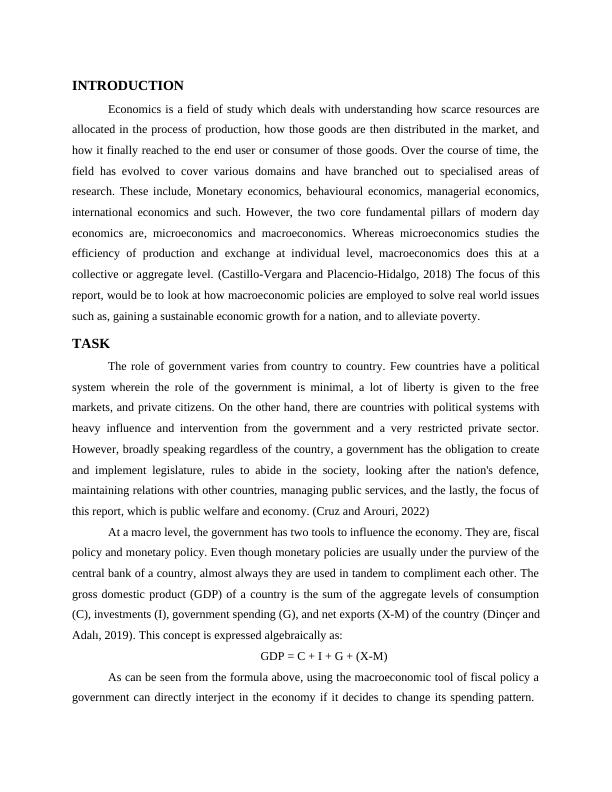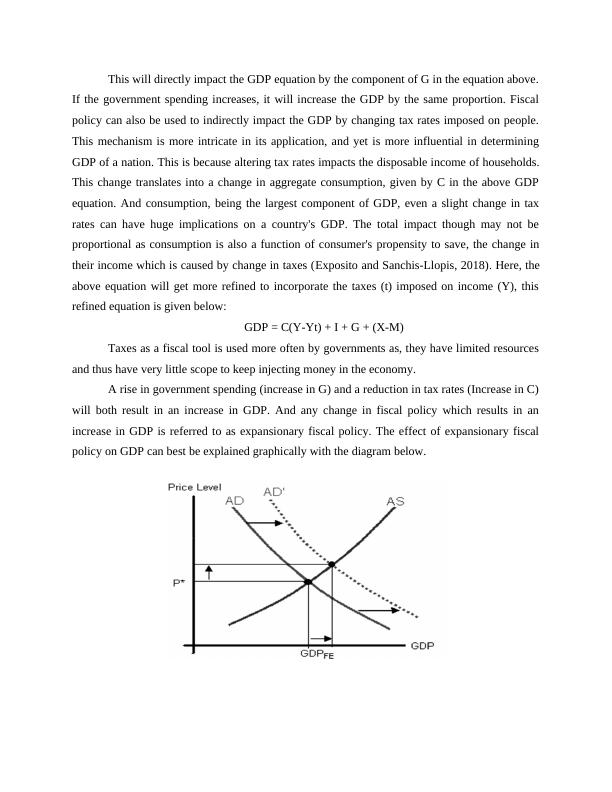Macroeconomic Policies for Sustainable Growth and Poverty Alleviation
Added on 2023-06-07
11 Pages3810 Words376 Views
Business Economics

Table of Contents
INTRODUCTION ..........................................................................................................................3
TASK...............................................................................................................................................3
CONCLUSION .............................................................................................................................10
REFERENCES..............................................................................................................................11
INTRODUCTION ..........................................................................................................................3
TASK...............................................................................................................................................3
CONCLUSION .............................................................................................................................10
REFERENCES..............................................................................................................................11

INTRODUCTION
Economics is a field of study which deals with understanding how scarce resources are
allocated in the process of production, how those goods are then distributed in the market, and
how it finally reached to the end user or consumer of those goods. Over the course of time, the
field has evolved to cover various domains and have branched out to specialised areas of
research. These include, Monetary economics, behavioural economics, managerial economics,
international economics and such. However, the two core fundamental pillars of modern day
economics are, microeconomics and macroeconomics. Whereas microeconomics studies the
efficiency of production and exchange at individual level, macroeconomics does this at a
collective or aggregate level. (Castillo-Vergara and Placencio-Hidalgo, 2018) The focus of this
report, would be to look at how macroeconomic policies are employed to solve real world issues
such as, gaining a sustainable economic growth for a nation, and to alleviate poverty.
TASK
The role of government varies from country to country. Few countries have a political
system wherein the role of the government is minimal, a lot of liberty is given to the free
markets, and private citizens. On the other hand, there are countries with political systems with
heavy influence and intervention from the government and a very restricted private sector.
However, broadly speaking regardless of the country, a government has the obligation to create
and implement legislature, rules to abide in the society, looking after the nation's defence,
maintaining relations with other countries, managing public services, and the lastly, the focus of
this report, which is public welfare and economy. (Cruz and Arouri, 2022)
At a macro level, the government has two tools to influence the economy. They are, fiscal
policy and monetary policy. Even though monetary policies are usually under the purview of the
central bank of a country, almost always they are used in tandem to compliment each other. The
gross domestic product (GDP) of a country is the sum of the aggregate levels of consumption
(C), investments (I), government spending (G), and net exports (X-M) of the country (Dinçer and
Adalı, 2019). This concept is expressed algebraically as:
GDP = C + I + G + (X-M)
As can be seen from the formula above, using the macroeconomic tool of fiscal policy a
government can directly interject in the economy if it decides to change its spending pattern.
Economics is a field of study which deals with understanding how scarce resources are
allocated in the process of production, how those goods are then distributed in the market, and
how it finally reached to the end user or consumer of those goods. Over the course of time, the
field has evolved to cover various domains and have branched out to specialised areas of
research. These include, Monetary economics, behavioural economics, managerial economics,
international economics and such. However, the two core fundamental pillars of modern day
economics are, microeconomics and macroeconomics. Whereas microeconomics studies the
efficiency of production and exchange at individual level, macroeconomics does this at a
collective or aggregate level. (Castillo-Vergara and Placencio-Hidalgo, 2018) The focus of this
report, would be to look at how macroeconomic policies are employed to solve real world issues
such as, gaining a sustainable economic growth for a nation, and to alleviate poverty.
TASK
The role of government varies from country to country. Few countries have a political
system wherein the role of the government is minimal, a lot of liberty is given to the free
markets, and private citizens. On the other hand, there are countries with political systems with
heavy influence and intervention from the government and a very restricted private sector.
However, broadly speaking regardless of the country, a government has the obligation to create
and implement legislature, rules to abide in the society, looking after the nation's defence,
maintaining relations with other countries, managing public services, and the lastly, the focus of
this report, which is public welfare and economy. (Cruz and Arouri, 2022)
At a macro level, the government has two tools to influence the economy. They are, fiscal
policy and monetary policy. Even though monetary policies are usually under the purview of the
central bank of a country, almost always they are used in tandem to compliment each other. The
gross domestic product (GDP) of a country is the sum of the aggregate levels of consumption
(C), investments (I), government spending (G), and net exports (X-M) of the country (Dinçer and
Adalı, 2019). This concept is expressed algebraically as:
GDP = C + I + G + (X-M)
As can be seen from the formula above, using the macroeconomic tool of fiscal policy a
government can directly interject in the economy if it decides to change its spending pattern.

This will directly impact the GDP equation by the component of G in the equation above.
If the government spending increases, it will increase the GDP by the same proportion. Fiscal
policy can also be used to indirectly impact the GDP by changing tax rates imposed on people.
This mechanism is more intricate in its application, and yet is more influential in determining
GDP of a nation. This is because altering tax rates impacts the disposable income of households.
This change translates into a change in aggregate consumption, given by C in the above GDP
equation. And consumption, being the largest component of GDP, even a slight change in tax
rates can have huge implications on a country's GDP. The total impact though may not be
proportional as consumption is also a function of consumer's propensity to save, the change in
their income which is caused by change in taxes (Exposito and Sanchis-Llopis, 2018). Here, the
above equation will get more refined to incorporate the taxes (t) imposed on income (Y), this
refined equation is given below:
GDP = C(Y-Yt) + I + G + (X-M)
Taxes as a fiscal tool is used more often by governments as, they have limited resources
and thus have very little scope to keep injecting money in the economy.
A rise in government spending (increase in G) and a reduction in tax rates (Increase in C)
will both result in an increase in GDP. And any change in fiscal policy which results in an
increase in GDP is referred to as expansionary fiscal policy. The effect of expansionary fiscal
policy on GDP can best be explained graphically with the diagram below.
If the government spending increases, it will increase the GDP by the same proportion. Fiscal
policy can also be used to indirectly impact the GDP by changing tax rates imposed on people.
This mechanism is more intricate in its application, and yet is more influential in determining
GDP of a nation. This is because altering tax rates impacts the disposable income of households.
This change translates into a change in aggregate consumption, given by C in the above GDP
equation. And consumption, being the largest component of GDP, even a slight change in tax
rates can have huge implications on a country's GDP. The total impact though may not be
proportional as consumption is also a function of consumer's propensity to save, the change in
their income which is caused by change in taxes (Exposito and Sanchis-Llopis, 2018). Here, the
above equation will get more refined to incorporate the taxes (t) imposed on income (Y), this
refined equation is given below:
GDP = C(Y-Yt) + I + G + (X-M)
Taxes as a fiscal tool is used more often by governments as, they have limited resources
and thus have very little scope to keep injecting money in the economy.
A rise in government spending (increase in G) and a reduction in tax rates (Increase in C)
will both result in an increase in GDP. And any change in fiscal policy which results in an
increase in GDP is referred to as expansionary fiscal policy. The effect of expansionary fiscal
policy on GDP can best be explained graphically with the diagram below.

End of preview
Want to access all the pages? Upload your documents or become a member.
Related Documents
Macroeconomics Models Essay 2022lg...
|12
|2068
|17
Macroeconomic Analysis of Australia using Aggregate Expenditure Modellg...
|13
|2403
|346
Macroeconomics Assignment (Solved)lg...
|12
|2416
|61
Macroeconomicslg...
|10
|1478
|75
Managerial Economics: Fiscal Policy, Monetary Policy and Taxationlg...
|7
|851
|307
Macroeconomic Assignmentlg...
|14
|2458
|266
